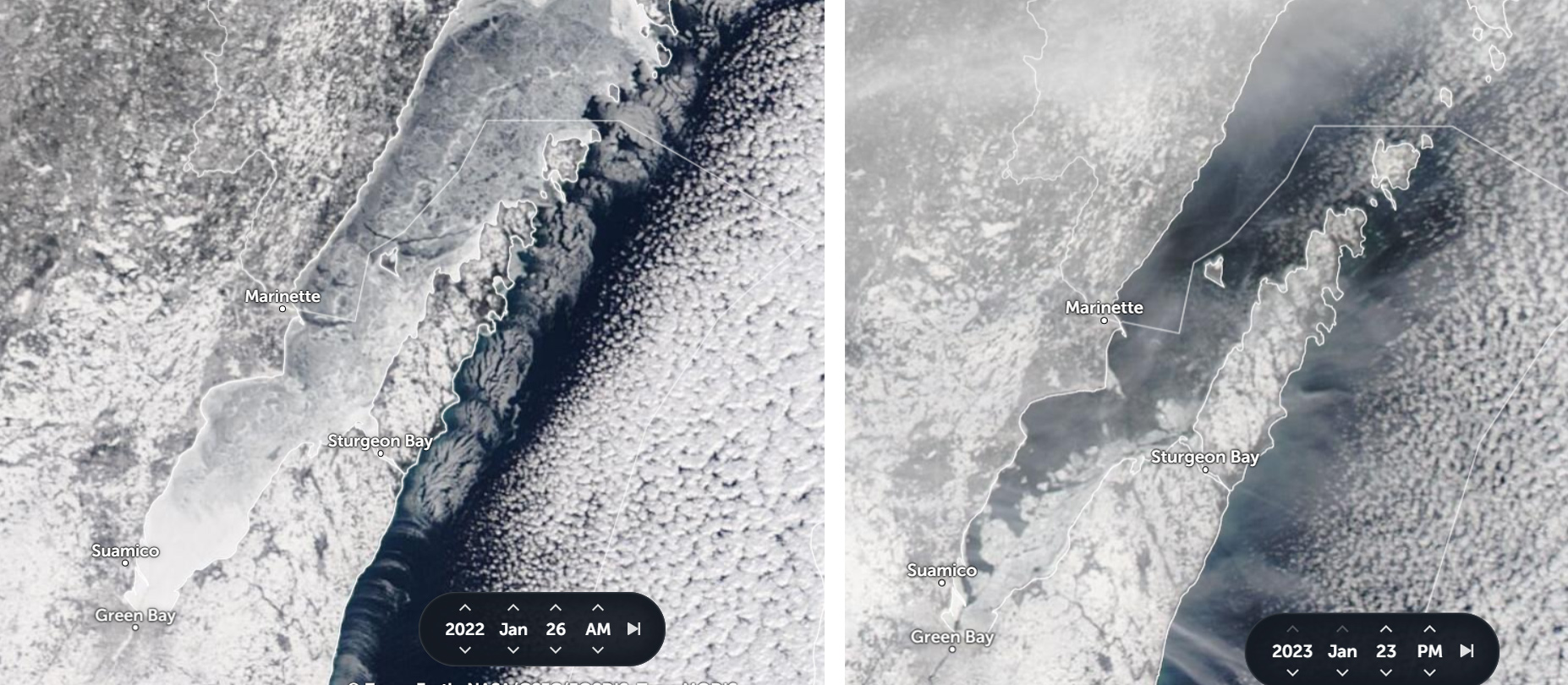It may seem early in the season to be thinking about water levels but not for us! We need to know what to expect in the months to come to be ready for what may, or may not, happen. Summer water levels tell us how much pier our customers will need and where to install boat lifts. With extreme highs come shoreline damage, extra pipe for longer legs and big, damaging waves. With extreme lows, not enough pier to get adequate depth, higher demand for pier sections and extra work setting boat lifts. We’ve seen both of these issues within the past ten years. So what can you expect for this coming summer?

In order to know where our water levels will be this summer, you have to look at the condition of the lakes in the winter. Our current ice concentration on the Great Lakes remains below normal. If you look at the pictures in reference A, you will see the difference between the ice formation in late January 2022 and 2023.
So why is ice important you might ask? The amount of ice and snow formed over the winter directly affects the water levels in our lakes and streams come summertime. Without snow, we don’t have the snowpack melt needed to refill our aquifers in spring. On average, the melt from the snowpack is responsible for one third of the ground water we see in spring. Even though we may not have much snow in our specific area, we benefit greatly from the connection of the Great Lakes. Heavy snow fall in southern Canada melts and fills Lake Superior which in turn flows into Lake Huron which is hydraulically connected to Lake Michigan. The more snow the better too because the ratio of snow to water is only 12:1, meaning you need about 12” of snow to generate 1” of water. As snowmelt fills our lakes and streams, ice protects them from evaporation and outflow. Statistically we have lost 30% of ice coverage on the Great Lakes since 1970. Reduced ice cover leads to increased evaporation and lower water levels, as well as an increase in water temperature and sunlight penetration. This has caused lake ice to form later than usual, about a day to a day and a half per decade. The rising surface water temperature has also affected “ice off” or the thaw dates for ice on the Great Lakes. Earlier ice off dates, which is currently about 24 days sooner since studies began in the early 1900’s, means the lake absorbs more heat over spring and summer perpetuating the late ice formation. Another effect of the warmer surface water, reduced ice cover, and increased evaporation is a corresponding increase in precipitation over nearby land, especially “lake effect” snow. This precipitation is depositing the water evaporated from the western lakes over eastern states starving the aquafers of the wester lake’s bordering states. A smaller role ice coverage plays is in the outflows of rivers and streams from the western lakes into the eastern lakes as they deposit into the Atlantic. The ice coverage helps reduce the flow of water between the lakes and without it, more water is flowing and depositing into the Atlantic throughout the winter without being replenished by icepack or precipitation.
Now that we know the condition of the lakes in winter, what can we expect this coming summer? Stay tuned for next months blog to find out what we are predicting for water levels in summer and what you can do to stay ahead of it.
Citation
- International Lake Superior Board of Control: https://ijc.org/en/lsbc/watershed/great-lakes-diversions
- International Lake Ontario – St. Lawrence River Bord: https://ijc.org/en/loslrb
- Climate.gov: https://www.climate.gov/news-features/featured-images/great-lakes-ice-cover-decreasing-over-last-40-years#:~:text=Less%20ice%20on%20the%20Great,leading%20to%20lower%20lake%20levels.
- United States Environmental Protection Agency:
- NOAA – Great Lakes Environmental Research Laboratory: https://www.glerl.noaa.gov/data/ice/#:~:text=Understanding%20the%20major%20effect%20of,it%20remains%20on%20the%20lakes.
- Britannica: https://www.britannica.com/place/Lake-Superior-lake-North-America
- Zoom Earth (photos): https://zoom.earth/





